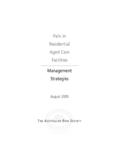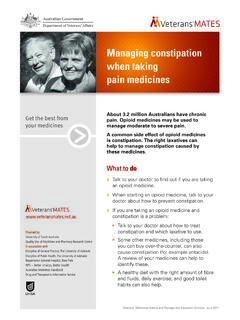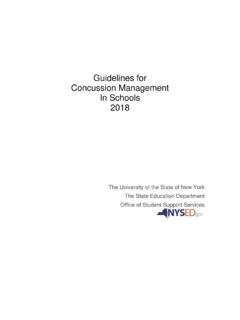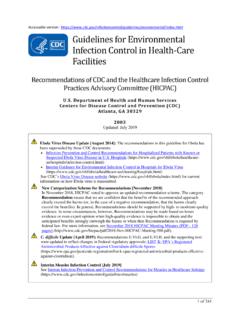Transcription of Pain in Residential Aged Care Facilities Management Strategies
1 Pain in Residential Aged care Facilities Management Strategies August 2005. T H E A U S T R A L I A N PA I N S O C I E T Y. Copyright The Australian Pain Society 2005. ISBN: 0-9757989-1-X. This work is copyright. Apart from any use as permitted under the Copyright Act 1968, no part may be reproduced by any process without prior written permission from the Australian Pain Society. Requests and inquiries concerning reproduction and rights should be addressed to: The Secretariat The Australian Pain Society PO Box 637 North Sydney NSW 2059 Australia Phone +61 2 9954 4400 Fax + 61 2 9954 0666. Additional copies can be downloaded from the Australian Pain Society website: Important Notice Medicine is an ever changing science. As new research and clinical experience broaden our knowledge, changes in treatment are required.
2 This work has been prepared by a panel of experts using the latest information available at the time. It is believed to be reliable. Because of the possibility of human error and advances in medical science, readers are encouraged to confirm the appropriateness of the information provided. This is particularly important in relation to prescription medications. iii P A I N I N. Foreword R E S I D E N T I A L A G E D. FOREWORD. C A R E F A C I L I T I E S M A N A G E M E N T S T R A T E G I E S. Unrecognised and poorly managed pain results in an unnecessary and serious decline in quality of life. Pain is not a normal part of the ageing process but the prevalence of persistent pain increases with age and illness, reaching its highest levels among older people residing in long-term care settings. Concern within the membership and executive of the Australian Pain Society about our most frail and vulnerable citizens, the 150,000 older people in our 3,000 Residential aged care Facilities , has led to the publication of these Management Strategies .
3 Research shows that unrecognised and untreated pain, especially non-cancer pain, is widespread among aged care residents. Because many residents have impaired cognition, more than 40 per cent of the Australian nursing home (high-level Residential care ). population is unable to even report pain. The implementation of carefully determined procedures for pain identification and assessment and an evidence based multidisciplinary approach to pain Management are the essentials for successful pain Management in aged care Facilities . Pain in Residential Aged care Facilities - Management Strategies is a comprehensive and considered exploration of the ways in which we can reduce pain and improve the quality of life of long-term aged care residents. The recommended Strategies are based on the best available research evidence.
4 There is also a great need for further research to improve this evidence base. iv P A I N I N. Foreword R E S I D E N T I A L A G E D. FOREWORD. C A R E F A C I L I T I E S M A N A G E M E N T S T R A T E G I E S. The causes of sub-optimal pain Management in the Residential aged care setting are complex and challenging. They include: A lack of appreciation of the extent and impact of unidentified pain Inconsistent pain identification, assessment and treatment procedures The particular spectrum of complex medical characteristics and care needs of the Residential aged care population Limited knowledge about contemporary multidisciplinary approaches to the assessment and treatment of persistent pain Limited clinical workforce availability in the Residential care sector A limited organisational infrastructure for delivering a multidisciplinary health service within the Residential care sector Limited interaction between Residential care clinicians and pain specialists Pain in Residential Aged care Facilities - Management Strategies , is the result of commitment, consultation and challenge.
5 I commend all of those involved and trust that the unprecedented guidance offered to all who care for Australian aged care facility residents, will be followed and implemented. Dr Carolyn Arnold, President The Australian Pain Society, July 2005. v T H E A U S T R A L I A N PA I N S O C I E T Y. P A I N I N R E S I D E N T I A L A G E D C A R E F A C I L I T I E S M A N A G E M E N T S T R A T E G I E S. The Australian Pain Society was formed in 1979 as the Australian Chapter of the International Association for the Study of Pain. It is a non-profit organisation and is directed by an elected honorary council. The APS is a multidisciplinary organisation. Its members represent many medical specialties as well as dentistry, psychology, nursing, general practice, other health professions and the basic sciences.
6 Membership now numbers in excess of 800 and includes investigators and clinicians who are active in the field of pain and its Management . The Society's Aims To foster and encourage research into pain mechanisms and pain syndromes. To help improve the Management of patients with acute and chronic pain by bringing together basic scientists, physicians and other health professionals of various disciplines and backgrounds who are interested in pain research and Management . To promote and to facilitate the dissemination of new information in the field of pain. To promote and sponsor the Annual Scientific Meeting of the Society. To encourage the adoption of uniform classifications, nomenclatures and definitions and the development of national and international data banks relating to pain and pain syndromes.
7 To inform the general public of the results and implications of current research in the field of pain. To advise national and regional agencies on standards relating to the use of drugs, appliances and procedures in the treatment of pain. To engage in such other activities as may be incidental to or in furtherance of the aforementioned aims. vi P A I N I N. Contents R E S I D E N T I A L A G E D. CONTENTS. C A R E F A C I L I T I E S M A N A G E M E N T S T R A T E G I E S. Foreword iv The Australian Pain Society vi Contents vii List of Tables and Figures viii List of Appendices ix Preface x Authors xi Summary xii Abbreviations xvi Section 1 Identification 1. Section 2 Assessment 7. Preamble to Sections 3, 4, 5 & 6 A Multidisciplinary Treatment Approach 18. Section 3 Pharmacological Treatments 21.
8 Section 4 Psychological - Educational Approaches 29. Section 5 Physical Therapies 37. Section 6 Complementary & Alternative Therapies 45. Section 7 Quality & Systems Issues 51. Appendices 1 - 14 63. Useful Websites 78. Pain Management Guidelines 79. Index 80. vii P A I N I N. Tables LIST. R E S I D E N T I A L. OF. A G E D. TA B L E S & F I G U R E S. C A R E F A C I L I T I E S M A N A G E M E N T S T R A T E G I E S. 1 Known barriers to acute pain identification Page 2. 2 Asking communicative residents about their pain 2. 3 Informant opinion of a resident's pain 4. 4 Staff observation: Common pain behaviours in cognitively impaired elderly persons 5. 5 Factors relevant to a pain assessment 9. 6 Factors & conditions associated with persistent non-cancer pain in long-term care populations 10. 7 The impact of pain 11.
9 8 The Resident's Verbal Brief Pain Inventory (RVBPI) 12. 9 The Abbey Pain Scale 15. 10 Non-pharmacological therapies for consideration in Residential care 18. 11 Interventional pain Management techniques in the elderly 19. 12 Bowel regimen for constipation 22. 13 Common components of psycho-educational therapy for the Management of persistent pain 30. 14 Prescription of strengthening exercises 38. 15 Prescription of aerobic exercises 39. 16 Prescription of stretching exercises 39. 17 Standards and Guidelines for Residential Aged care Services 1998 52. 18 Quality indicators for pain Management in vulnerable elders 54. 19 Quality indicators for the Management of osteoarthritis in vulnerable elders 54. 20 Pain assessment indicators for pain documentation review 56. 21 Target indicators for pain Management practice in institutions 58.
10 22 Attributes of an ideal pain Management system 59. 23 Joint Commission on Accreditation of Healthcare Organizations (JCAHO) requirements 60. 24 Education topics and format 60. FIGURE 1. Recommended organisation, responsibilities and relationships for the care of residents with pain 57. viii P A I N. Appendices I N R E S I D E N T I A L. LIST. A G E D. OF. C A R E. APPENDICES. F A C I L I T I E S M A N A G E M E N T S T R A T E G I E S. Appendix 1 Acknowledgements Appendix 2 Components of initial pain assessment recommended by the American Geriatrics Society Panel on Persistent Pain in Older Persons (2002). Appendix 3 The Brief Pain Inventory (BPI): Background Appendix 4 Brief Pain Inventory (BPI): Translations and validations Appendix 5 The Present Pain Inventory (PPI). Appendix 6 Pain Thermometer Appendix 7 The Pain Assessment In Advanced Dementia (PAINAD) Scale Appendix 8 Visual Analogue Scale Appendix 9 Pictorial or Faces Pain Scales Appendix 10 Other review instruments: The Memorial Symptom Assessment Scale (MSAS).








